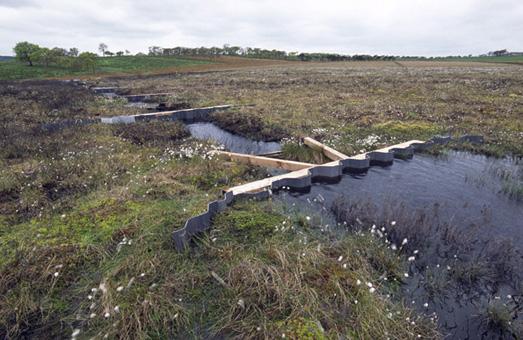Case-study /
Improving Habitat Management: restoring a lowland raised bog at Blawhorn Moss National Nature Reserve, Central Scotland


Safeguarding raised peat bogs- Dammed ditch on Blawhorn Moss
Safeguarding peat bogs and their stored carbon
Climate change could have severe consequences for the locations in which peat accumulation can continue in future. Recent research has highlighted that some lowland raised bogs in Scotland face climatic stress under the projected hotter and drier summers of the future.
Raised bogs in particular are vulnerable to climate stress since they are rainfall dependent, and their raised surfaces are so-called because they sit above the water table. Climate change could have a major impact on the hydrological systems of these bogs, and their species composition.
Degraded raised bogs are carbon liabilities. When the water table drops, peat stops forming. This changes the bog from being an effective carbon sink to a significant source of greenhouse gas emissions, further contributing to climate change. Drying of the surface also results in the loss of specialist (and often scarce) bog-loving plants and animals. If bogs dry out they are more susceptible to damage from summer wildfires, which may also increase with climate change.
The bogs most at risk of damage from climate stress are those which have a history of poor management, particularly sites which have been deliberately drained to improve grazing for livestock or for forestry.
Blawhorn Moss National Nature Reserve (NNR) is one such site, formerly drained by a network of ditches and at times suffering fire damage. The resulting loss of bog-moss (Sphagnum), replaced by more stress-tolerant grasses and shrubs, left the site more vulnerable to the climate stress it is expected to face in the future.
Improving habitat management is a key option in helping nature adapt to climate change. At Blawhorn Moss, Scottish Natural Heritage is improving management to help the site adapt to the increasing climate stress it faces. Action has included:
- blocking drainage ditches with dams to reduce run-off, erosion and fragmentation of the bog surface. Crucially, this also raises water levels and encourages Sphagnumgrowth. There are now over 1000 dams on the site.
- removing shrubs and trees (their deeper roots dry out the surface more).
- working with local landowners to change the grazing programme to increase species diversity and reduce the dominance of heather (Calluna).
The improved habitat management has been successful. Blawhorn now has new areas of Sphagnumgrowth (the first step in peat formation and therefore carbon storage) and increased resilience to summer fires. The higher water table will help act as a buffer to the effects of the warmer, drier summers expected in the future. The improved management of the bog habitat will help Blawhorn adapt in our warming world and help ensure the bog continues to bring many benefits.
